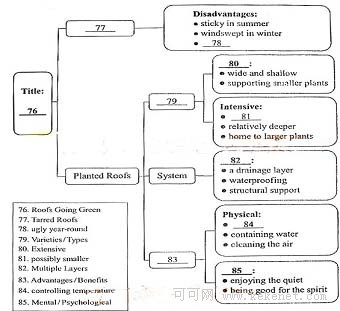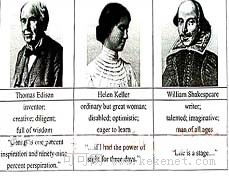第四部分:書面表達(dá)(共兩節(jié),滿分35分)
第一節(jié) 填空(共10個小題, 每小題1分,滿分10分)
閱讀下面短文,根據(jù)所談內(nèi)容在文后第76題至85小題的空格里填上恰當(dāng)?shù)膯卧~或短語。
注意:每空不超過3個單詞。
The best thing you can say about the roofs of most city building is that you don’t have to look at them much. That’s very good, since an urban landscape viewed from above can be an unlovely thing—block after block of tarred (鋪有瀝青的) black rooftops, sticky in summer, windswept in winter, ugly year-round. Or at least that’s the way it used to be.
But urban roofs are going green. Environmental designers have begun to realize that the tops of buildings don’t have to be wastelands. Indeed, they can be gardens, planted with grasses, flowers and bushes.
A planted roof usually comes in one of the two varieties: extensive or intensive. The extensive type is wide and shallow, with a soil depth of less than 8 inches, able to support smaller plants. The intensive type may smaller, but it’s relatively deeper and home to larger plants.Whatever the design, green roofs are not so simple as ordinary gardens. They have multiple layers beneath the soil, including a drainage layer, waterproofing, structural support, and so on.
But this system can do a great deal of good. A recent paper in the journal BioScience tells that green roofs can control temperature, contain water and clean the air, And most impressively, they can cut heat loss from a building by 50%, lower air-conditioning costs by 25%, and reduce the urban-heated-island effect by 2°C.
Of course, apart from the square feet greened and heat reduced, green roofs are even more valued since people can gain some psychological comfort simply by having a quiet place to go. As so often happens, what’s good for the planet can also be good for the spirit.
第二節(jié) 寫作(滿分25分)
請從下列人物中選擇你最喜歡的一位,用英語寫一篇120詞左右的短文。要求根據(jù)所給信息作適當(dāng)發(fā)揮,且需包括以下三部分內(nèi)容:
1. 對該人物的簡單介紹:
2. 喜歡該人物的理由:












